-
缓存-多级缓存
1.什么是多级缓存
传统的缓存策略一般是请求到达Tomcat后,先查询Redis,如果未命中则查询数据库,如图:
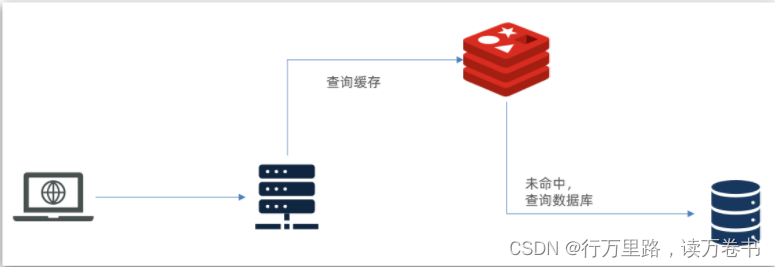
存在下面的问题:- 请求要经过Tomcat处理,Tomcat的性能成为整个系统的瓶颈
- Redis缓存失效时,会对数据库产生冲击
多级缓存就是充分利用请求处理的每个环节,分别添加缓存,减轻Tomcat压力,提升服务性能:
- 浏览器访问静态资源时,优先读取浏览器本地缓存
- 访问非静态资源(ajax查询数据)时,访问服务端
- 请求到达Nginx后,优先读取Nginx本地缓存
- 如果Nginx本地缓存未命中,则去直接查询Redis(不经过Tomcat)
- 如果Redis查询未命中,则查询Tomcat
- 请求进入Tomcat后,优先查询JVM进程缓存
- 如果JVM进程缓存未命中,则查询数据库
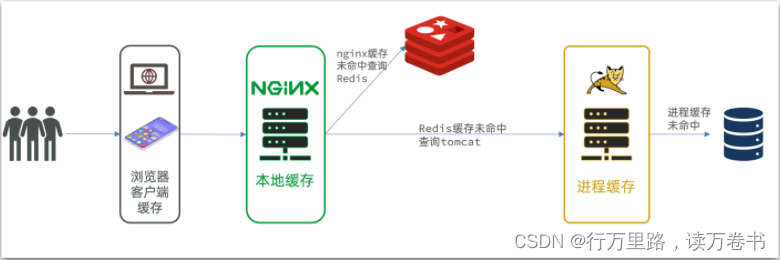
在多级缓存架构中,Nginx内部需要编写本地缓存查询、Redis查询、Tomcat查询的业务逻辑,因此这样的nginx服务不再是一个反向代理服务器,而是一个编写业务的Web服务器了。
因此这样的业务Nginx服务也需要搭建集群来提高并发,再有专门的nginx服务来做反向代理,如图:
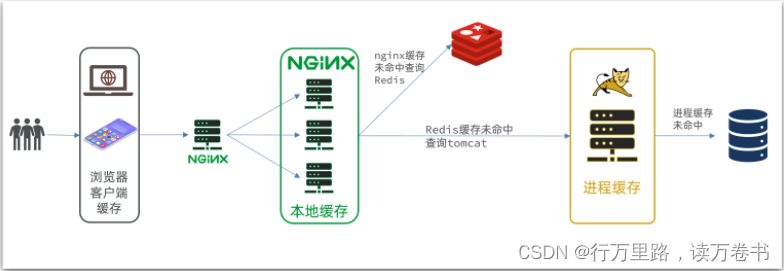
另外,我们的Tomcat服务将来也会部署为集群模式:

可见,多级缓存的关键有两个:- 一个是在nginx中编写业务,实现nginx本地缓存、Redis、Tomcat的查询
- 另一个就是在Tomcat中实现JVM进程缓存
其中Nginx编程则会用到OpenResty框架结合Lua这样的语言。
2.JVM进程缓存
2.1.初识Caffeine
缓存在日常开发中启动至关重要的作用,由于是存储在内存中,数据的读取速度是非常快的,能大量减少对数据库的访问,减少数据库的压力。我们把缓存分为两类:
- 分布式缓存,例如Redis:
- 优点:存储容量更大、可靠性更好、可以在集群间共享
- 缺点:访问缓存有网络开销
- 场景:缓存数据量较大、可靠性要求较高、需要在集群间共享
- 进程本地缓存,例如HashMap、GuavaCache:
- 优点:读取本地内存,没有网络开销,速度更快
- 缺点:存储容量有限、可靠性较低、无法共享
- 场景:性能要求较高,缓存数据量较小
Caffeine是一个基于Java8开发的,提供了近乎最佳命中率的高性能的本地缓存库。目前Spring内部的缓存使用的就是Caffeine。GitHub地址:https://github.com/ben-manes/caffeine
Caffeine的性能非常好,下图是官方给出的性能对比:
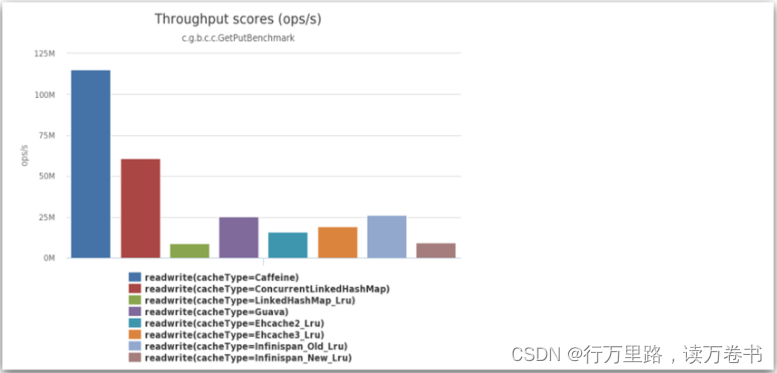
可以看到Caffeine的性能遥遥领先!
缓存使用的基本API:@Test void testBasicOps() { // 构建cache对象 Cache<String, String> cache = Caffeine.newBuilder().build(); // 存数据 cache.put("gf", "迪丽热巴"); // 取数据 String gf = cache.getIfPresent("gf"); System.out.println("gf = " + gf); // 取数据,包含两个参数: // 参数一:缓存的key // 参数二:Lambda表达式,表达式参数就是缓存的key,方法体是查询数据库的逻辑 // 优先根据key查询JVM缓存,如果未命中,则执行参数二的Lambda表达式 String defaultGF = cache.get("defaultGF", key -> { // 根据key去数据库查询数据 return "柳岩"; }); System.out.println("defaultGF = " + defaultGF); }- 1
- 2
- 3
- 4
- 5
- 6
- 7
- 8
- 9
- 10
- 11
- 12
- 13
- 14
- 15
- 16
- 17
- 18
- 19
- 20
- 21
- 22
Caffeine既然是缓存的一种,肯定需要有缓存的清除策略,不然的话内存总会有耗尽的时候。
Caffeine提供了三种缓存驱逐策略:- 基于容量:设置缓存的数量上限
// 创建缓存对象 Cache<String, String> cache = Caffeine.newBuilder() .maximumSize(1) // 设置缓存大小上限为 1 .build();- 1
- 2
- 3
- 4
- 基于时间:设置缓存的有效时间
// 创建缓存对象 Cache<String, String> cache = Caffeine.newBuilder() // 设置缓存有效期为 10 秒,从最后一次写入开始计时 .expireAfterWrite(Duration.ofSeconds(10)) .build();- 1
- 2
- 3
- 4
- 5
- 基于引用:设置缓存为软引用或弱引用,利用GC来回收缓存数据。性能较差,不建议使用。
注意:在默认情况下,当一个缓存元素过期的时候,Caffeine不会自动立即将其清理和驱逐。而是在一次读或写操作后,或者在空闲时间完成对失效数据的驱逐。
2.2.实现JVM进程缓存
2.3.1.需求
利用Caffeine实现下列需求:
- 给根据id查询商品的业务添加缓存,缓存未命中时查询数据库
- 给根据id查询商品库存的业务添加缓存,缓存未命中时查询数据库
- 缓存初始大小为100
- 缓存上限为10000
2.3.2.实现
首先,我们需要定义两个Caffeine的缓存对象,分别保存商品、库存的缓存数据。
在item-service的com.heima.item.config包下定义CaffeineConfig类:package com.heima.item.config; import com.github.benmanes.caffeine.cache.Cache; import com.github.benmanes.caffeine.cache.Caffeine; import com.heima.item.pojo.Item; import com.heima.item.pojo.ItemStock; import org.springframework.context.annotation.Bean; import org.springframework.context.annotation.Configuration; @Configuration public class CaffeineConfig { @Bean public Cache<Long, Item> itemCache(){ return Caffeine.newBuilder() .initialCapacity(100) .maximumSize(10_000) .build(); } @Bean public Cache<Long, ItemStock> stockCache(){ return Caffeine.newBuilder() .initialCapacity(100) .maximumSize(10_000) .build(); } }- 1
- 2
- 3
- 4
- 5
- 6
- 7
- 8
- 9
- 10
- 11
- 12
- 13
- 14
- 15
- 16
- 17
- 18
- 19
- 20
- 21
- 22
- 23
- 24
- 25
- 26
- 27
- 28
然后,修改item-service中的com.heima.item.web包下的ItemController类,添加缓存逻辑:
@RestController @RequestMapping("item") public class ItemController { @Autowired private IItemService itemService; @Autowired private IItemStockService stockService; @Autowired private Cache<Long, Item> itemCache; @Autowired private Cache<Long, ItemStock> stockCache; // ...其它略 @GetMapping("/{id}") public Item findById(@PathVariable("id") Long id) { return itemCache.get(id, key -> itemService.query() .ne("status", 3).eq("id", key) .one() ); } @GetMapping("/stock/{id}") public ItemStock findStockById(@PathVariable("id") Long id) { return stockCache.get(id, key -> stockService.getById(key)); } }- 1
- 2
- 3
- 4
- 5
- 6
- 7
- 8
- 9
- 10
- 11
- 12
- 13
- 14
- 15
- 16
- 17
- 18
- 19
- 20
- 21
- 22
- 23
- 24
- 25
- 26
- 27
- 28
- 29
3.Lua语法入门
Nginx编程需要用到Lua语言,因此我们必须先入门Lua的基本语法。
3.1.初识Lua
Lua 是一种轻量小巧的脚本语言,用标准C语言编写并以源代码形式开放, 其设计目的是为了嵌入应用程序中,从而为应用程序提供灵活的扩展和定制功能。官网:https://www.lua.org/

Lua经常嵌入到C语言开发的程序中,例如游戏开发、游戏插件等。
Nginx本身也是C语言开发,因此也允许基于Lua做拓展。3.2.HelloWorld
CentOS7默认已经安装了Lua语言环境,所以可以直接运行Lua代码。
1)在Linux虚拟机的任意目录下,新建一个hello.lua文件

2)添加下面的内容print("Hello World!")- 1
3)运行

3.3.变量和循环
Lua中支持的常见数据类型包括:

另外,Lua提供了type()函数来判断一个变量的数据类型:

3.3.2.声明变量
Lua声明变量的时候无需指定数据类型,而是用local来声明变量为局部变量:
-- 声明字符串,可以用单引号或双引号, local str = 'hello' -- 字符串拼接可以使用 .. local str2 = 'hello' .. 'world' -- 声明数字 local num = 21 -- 声明布尔类型 local flag = true- 1
- 2
- 3
- 4
- 5
- 6
- 7
- 8
Lua中的table类型既可以作为数组,又可以作为Java中的map来使用。数组就是特殊的table,key是数组角标而已:
-- 声明数组 ,key为角标的 table local arr = {'java', 'python', 'lua'} -- 声明table,类似java的map local map = {name='Jack', age=21}- 1
- 2
- 3
- 4
Lua中的数组角标是从1开始,访问的时候与Java中类似:
-- 访问数组,lua数组的角标从1开始 print(arr[1])- 1
- 2
Lua中的table可以用key来访问:
-- 访问table print(map['name']) print(map.name)- 1
- 2
- 3
3.3.3.循环
对于table,我们可以利用for循环来遍历。不过数组和普通table遍历略有差异。
遍历数组:-- 声明数组 key为索引的 table local arr = {'java', 'python', 'lua'} -- 遍历数组 for index,value in ipairs(arr) do print(index, value) end- 1
- 2
- 3
- 4
- 5
- 6
遍历普通table
-- 声明map,也就是table local map = {name='Jack', age=21} -- 遍历table for key,value in pairs(map) do print(key, value) end- 1
- 2
- 3
- 4
- 5
- 6
3.4.条件控制、函数
Lua中的条件控制和函数声明与Java类似。
3.4.1.函数
定义函数的语法:
function 函数名( argument1, argument2..., argumentn) -- 函数体 return 返回值 end- 1
- 2
- 3
- 4
例如,定义一个函数,用来打印数组:
function printArr(arr) for index, value in ipairs(arr) do print(value) end end- 1
- 2
- 3
- 4
- 5
3.4.2.条件控制
类似Java的条件控制,例如if、else语法:
if(布尔表达式) then --[ 布尔表达式为 true 时执行该语句块 --] else --[ 布尔表达式为 false 时执行该语句块 --] end- 1
- 2
- 3
- 4
- 5
- 6
与java不同,布尔表达式中的逻辑运算是基于英文单词:

3.4.3.案例
需求:自定义一个函数,可以打印table,当参数为nil时,打印错误信息
function printArr(arr) if not arr then print('数组不能为空!') end for index, value in ipairs(arr) do print(value) end end- 1
- 2
- 3
- 4
- 5
- 6
- 7
- 8
4.实现多级缓存
多级缓存的实现离不开Nginx编程,而Nginx编程又离不开OpenResty。
4.1.安装OpenResty
OpenResty® 是一个基于 Nginx的高性能 Web 平台,用于方便地搭建能够处理超高并发、扩展性极高的动态 Web 应用、Web 服务和动态网关。具备下列特点:
- 具备Nginx的完整功能
- 基于Lua语言进行扩展,集成了大量精良的 Lua 库、第三方模块
- 允许使用Lua自定义业务逻辑、自定义库
官方网站: https://openresty.org/cn/

4.2.OpenResty快速入门
我们希望达到的多级缓存架构如图:

其中:- windows上的nginx用来做反向代理服务,将前端的查询商品的ajax请求代理到OpenResty集群
- OpenResty集群用来编写多级缓存业务
4.2.1.反向代理流程
现在,商品详情页使用的是假的商品数据。不过在浏览器中,可以看到页面有发起ajax请求查询真实商品数据。
这个请求如下:

请求地址是localhost,端口是80,就被windows上安装的Nginx服务给接收到了。然后代理给了OpenResty集群:
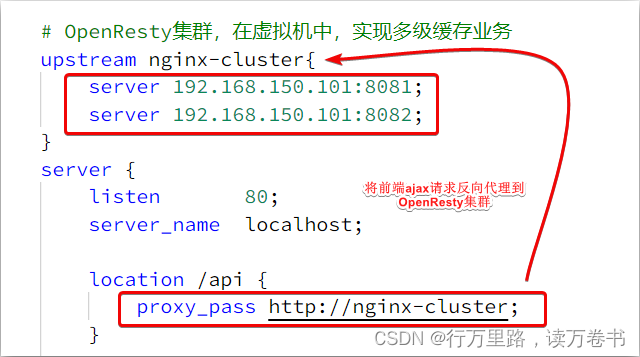
我们需要在OpenResty中编写业务,查询商品数据并返回到浏览器。
但是这次,我们先在OpenResty接收请求,返回假的商品数据。4.2.2.OpenResty监听请求
OpenResty的很多功能都依赖于其目录下的Lua库,需要在nginx.conf中指定依赖库的目录,并导入依赖:
1)添加对OpenResty的Lua模块的加载
修改/usr/local/openresty/nginx/conf/nginx.conf文件,在其中的http下面,添加下面代码:#lua 模块 lua_package_path "/usr/local/openresty/lualib/?.lua;;"; #c模块 lua_package_cpath "/usr/local/openresty/lualib/?.so;;";- 1
- 2
- 3
- 4
2)监听/api/item路径
修改/usr/local/openresty/nginx/conf/nginx.conf文件,在nginx.conf的server下面,添加对/api/item这个路径的监听:location /api/item { # 默认的响应类型 default_type application/json; # 响应结果由lua/item.lua文件来决定 content_by_lua_file lua/item.lua; }- 1
- 2
- 3
- 4
- 5
- 6
这个监听,就类似于SpringMVC中的@GetMapping(“/api/item”)做路径映射。
而content_by_lua_file lua/item.lua则相当于调用item.lua这个文件,执行其中的业务,把结果返回给用户。相当于java中调用service。4.2.3.编写item.lua
1)在/usr/loca/openresty/nginx目录创建文件夹:lua

2)在/usr/loca/openresty/nginx/lua文件夹下,新建文件:item.lua

3)编写item.lua,返回假数据
item.lua中,利用ngx.say()函数返回数据到Response中ngx.say('{"id":10001,"name":"SALSA AIR","title":"RIMOWA 21寸托运箱拉杆箱 SALSA AIR系列果绿色 820.70.36.4","price":17900,"image":"https://m.360buyimg.com/mobilecms/s720x720_jfs/t6934/364/1195375010/84676/e9f2c55f/597ece38N0ddcbc77.jpg!q70.jpg.webp","category":"拉杆箱","brand":"RIMOWA","spec":"","status":1,"createTime":"2019-04-30T16:00:00.000+00:00","updateTime":"2019-04-30T16:00:00.000+00:00","stock":2999,"sold":31290}')- 1
4)重新加载配置
nginx -s reload- 1
刷新商品页面:http://localhost/item.html?id=1001,即可看到效果:

4.3.请求参数处理
要返回真实数据,必须根据前端传递来的商品id,查询商品信息才可以。
那么如何获取前端传递的商品参数呢?4.3.1.获取参数的API
OpenResty中提供了一些API用来获取不同类型的前端请求参数:
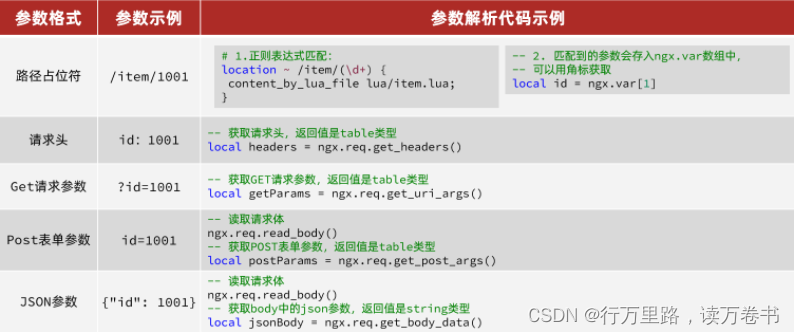
4.3.2.获取参数并返回
在前端发起的ajax请求如图:

可以看到商品id是以路径占位符方式传递的,因此可以利用正则表达式匹配的方式来获取ID
1)获取商品id
修改/usr/loca/openresty/nginx/nginx.conf文件中监听/api/item的代码,利用正则表达式获取ID:location ~ /api/item/(\d+) { # 默认的响应类型 default_type application/json; # 响应结果由lua/item.lua文件来决定 content_by_lua_file lua/item.lua; }- 1
- 2
- 3
- 4
- 5
- 6
2)拼接ID并返回
修改/usr/loca/openresty/nginx/lua/item.lua文件,获取id并拼接到结果中返回:-- 获取商品id local id = ngx.var[1] -- 拼接并返回 ngx.say('{"id":' .. id .. ',"name":"SALSA AIR","title":"RIMOWA 21寸托运箱拉杆箱 SALSA AIR系列果绿色 820.70.36.4","price":17900,"image":"https://m.360buyimg.com/mobilecms/s720x720_jfs/t6934/364/1195375010/84676/e9f2c55f/597ece38N0ddcbc77.jpg!q70.jpg.webp","category":"拉杆箱","brand":"RIMOWA","spec":"","status":1,"createTime":"2019-04-30T16:00:00.000+00:00","updateTime":"2019-04-30T16:00:00.000+00:00","stock":2999,"sold":31290}')- 1
- 2
- 3
- 4
3)重新加载并测试
运行命令以重新加载OpenResty配置:nginx -s reload- 1
刷新页面可以看到结果中已经带上了ID:
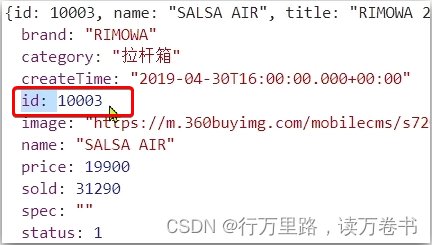
4.4.查询Tomcat
拿到商品ID后,本应去缓存中查询商品信息,不过目前我们还未建立nginx、redis缓存。因此,这里我们先根据商品id去tomcat查询商品信息。我们实现如图部分:

需要注意的是,我们的OpenResty是在虚拟机,Tomcat是在Windows电脑上。两者IP一定不要搞错了。
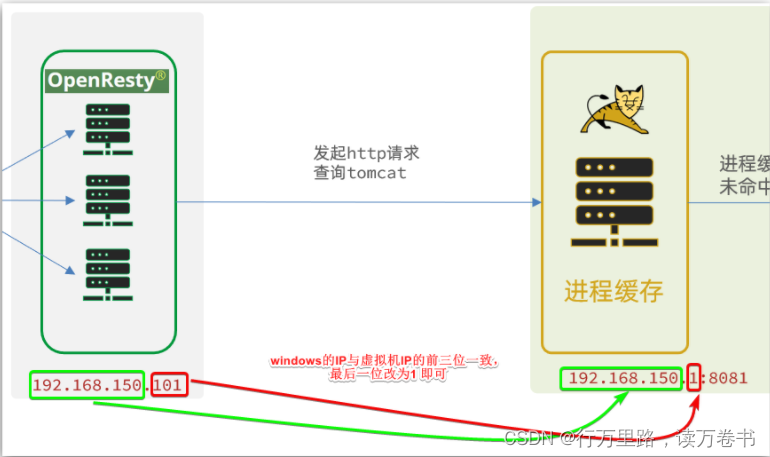
4.4.1.发送http请求的API
nginx提供了内部API用以发送http请求:
local resp = ngx.location.capture("/path",{ method = ngx.HTTP_GET, -- 请求方式 args = {a=1,b=2}, -- get方式传参数 })- 1
- 2
- 3
- 4
返回的响应内容包括:
- resp.status:响应状态码
- resp.header:响应头,是一个table
- resp.body:响应体,就是响应数据
注意:这里的path是路径,并不包含IP和端口。这个请求会被nginx内部的server监听并处理。
但是我们希望这个请求发送到Tomcat服务器,所以还需要编写一个server来对这个路径做反向代理:location /path { # 这里是windows电脑的ip和Java服务端口,需要确保windows防火墙处于关闭状态 proxy_pass http://192.168.150.1:8081; }- 1
- 2
- 3
- 4
原理如图:
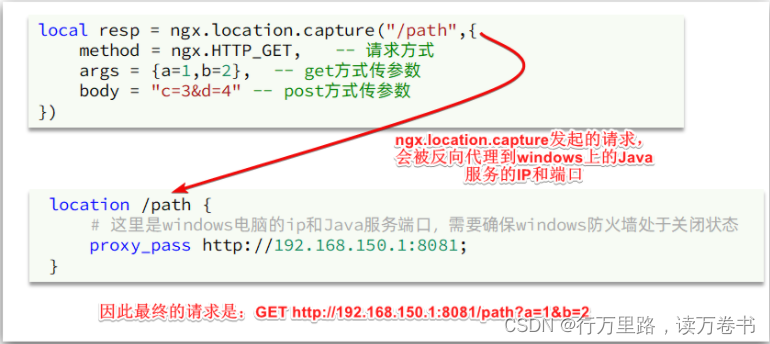
4.4.2.封装http工具
下面,我们封装一个发送Http请求的工具,基于ngx.location.capture来实现查询tomcat。
1)添加反向代理,到windows的Java服务
因为item-service中的接口都是/item开头,所以我们监听/item路径,代理到windows上的tomcat服务。
修改 /usr/local/openresty/nginx/conf/nginx.conf文件,添加一个location:location /item { proxy_pass http://192.168.150.1:8081; }- 1
- 2
- 3
以后,只要我们调用ngx.location.capture(“/item”),就一定能发送请求到windows的tomcat服务。
2)封装工具类
之前我们说过,OpenResty启动时会加载以下两个目录中的工具文件:

所以,自定义的http工具也需要放到这个目录下。
在/usr/local/openresty/lualib目录下,新建一个common.lua文件:vi /usr/local/openresty/lualib/common.lua- 1
内容如下:
-- 封装函数,发送http请求,并解析响应 local function read_http(path, params) local resp = ngx.location.capture(path,{ method = ngx.HTTP_GET, args = params, }) if not resp then -- 记录错误信息,返回404 ngx.log(ngx.ERR, "http请求查询失败, path: ", path , ", args: ", args) ngx.exit(404) end return resp.body end -- 将方法导出 local _M = { read_http = read_http } return _M- 1
- 2
- 3
- 4
- 5
- 6
- 7
- 8
- 9
- 10
- 11
- 12
- 13
- 14
- 15
- 16
- 17
- 18
这个工具将read_http函数封装到_M这个table类型的变量中,并且返回,这类似于导出。
使用的时候,可以利用require(‘common’)来导入该函数库,这里的common是函数库的文件名。
3)实现商品查询
最后,我们修改/usr/local/openresty/lua/item.lua文件,利用刚刚封装的函数库实现对tomcat的查询:-- 引入自定义common工具模块,返回值是common中返回的 _M local common = require("common") -- 从 common中获取read_http这个函数 local read_http = common.read_http -- 获取路径参数 local id = ngx.var[1] -- 根据id查询商品 local itemJSON = read_http("/item/".. id, nil) -- 根据id查询商品库存 local itemStockJSON = read_http("/item/stock/".. id, nil)- 1
- 2
- 3
- 4
- 5
- 6
- 7
- 8
- 9
- 10
这里查询到的结果是json字符串,并且包含商品、库存两个json字符串,页面最终需要的是把两个json拼接为一个json:
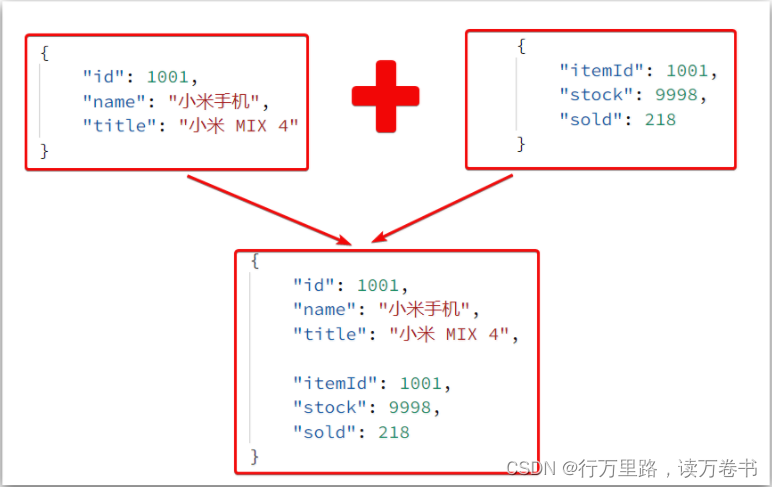
这就需要我们先把JSON变为lua的table,完成数据整合后,再转为JSON。4.4.3.CJSON工具类
OpenResty提供了一个cjson的模块用来处理JSON的序列化和反序列化。
官方地址: https://github.com/openresty/lua-cjson/
1)引入cjson模块:local cjson = require "cjson"- 1
2)序列化:
local obj = { name = 'jack', age = 21 } -- 把 table 序列化为 json local json = cjson.encode(obj)- 1
- 2
- 3
- 4
- 5
- 6
3)反序列化:
local json = '{"name": "jack", "age": 21}' -- 反序列化 json为 table local obj = cjson.decode(json); print(obj.name)- 1
- 2
- 3
- 4
4.4.4.实现Tomcat查询
下面,我们修改之前的item.lua中的业务,添加json处理功能:
-- 导入common函数库 local common = require('common') local read_http = common.read_http -- 导入cjson库 local cjson = require('cjson') -- 获取路径参数 local id = ngx.var[1] -- 根据id查询商品 local itemJSON = read_http("/item/".. id, nil) -- 根据id查询商品库存 local itemStockJSON = read_http("/item/stock/".. id, nil) -- JSON转化为lua的table local item = cjson.decode(itemJSON) local stock = cjson.decode(stockJSON) -- 组合数据 item.stock = stock.stock item.sold = stock.sold -- 把item序列化为json 返回结果 ngx.say(cjson.encode(item))- 1
- 2
- 3
- 4
- 5
- 6
- 7
- 8
- 9
- 10
- 11
- 12
- 13
- 14
- 15
- 16
- 17
- 18
- 19
- 20
- 21
- 22
- 23
4.4.5.基于ID负载均衡
刚才的代码中,我们的tomcat是单机部署。而实际开发中,tomcat一定是集群模式:

因此,OpenResty需要对tomcat集群做负载均衡。
而默认的负载均衡规则是轮询模式,当我们查询/item/10001时:- 第一次会访问8081端口的tomcat服务,在该服务内部就形成了JVM进程缓存
- 第二次会访问8082端口的tomcat服务,该服务内部没有JVM缓存(因为JVM缓存无法共享),会查询数据库
- …
你看,因为轮询的原因,第一次查询8081形成的JVM缓存并未生效,直到下一次再次访问到8081时才可以生效,缓存命中率太低了。
怎么办?
如果能让同一个商品,每次查询时都访问同一个tomcat服务,那么JVM缓存就一定能生效了。
也就是说,我们需要根据商品id做负载均衡,而不是轮询。
1)原理
nginx提供了基于请求路径做负载均衡的算法:
nginx根据请求路径做hash运算,把得到的数值对tomcat服务的数量取余,余数是几,就访问第几个服务,实现负载均衡。例如:
- 我们的请求路径是 /item/10001
- tomcat总数为2台(8081、8082)
- 对请求路径/item/1001做hash运算求余的结果为1
- 则访问第一个tomcat服务,也就是8081
只要id不变,每次hash运算结果也不会变,那就可以保证同一个商品,一直访问同一个tomcat服务,确保JVM缓存生效。
2)实现
修改/usr/local/openresty/nginx/conf/nginx.conf文件,实现基于ID做负载均衡。
首先,定义tomcat集群,并设置基于路径做负载均衡:upstream tomcat-cluster { hash $request_uri; server 192.168.150.1:8081; server 192.168.150.1:8082; }- 1
- 2
- 3
- 4
- 5
然后,修改对tomcat服务的反向代理,目标指向tomcat集群:
location /item { proxy_pass http://tomcat-cluster; }- 1
- 2
- 3
重新加载OpenResty
nginx -s reload- 1
3)测试
启动两台tomcat服务:
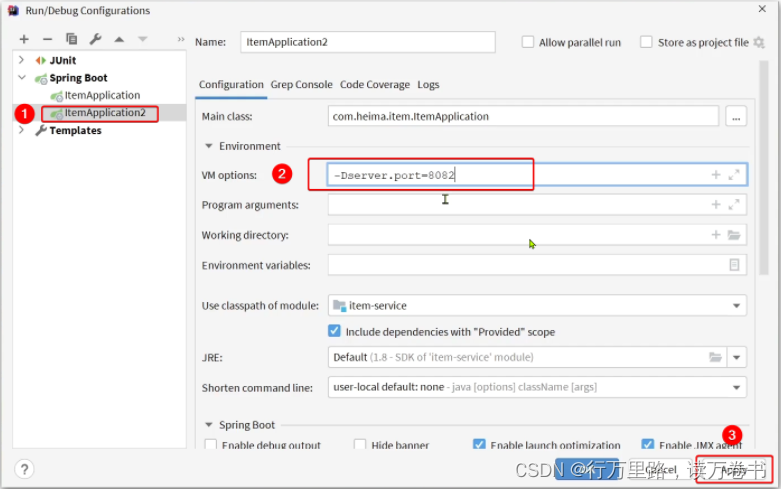
同时启动:

清空日志后,再次访问页面,可以看到不同id的商品,访问到了不同的tomcat服务:
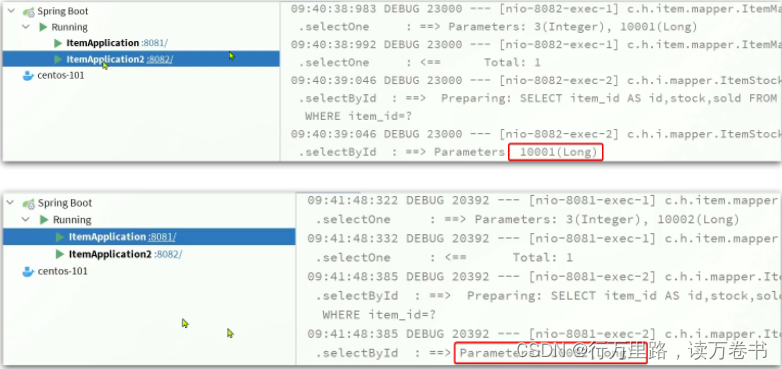
4.5.Redis缓存预热
Redis缓存会面临冷启动问题:
冷启动:服务刚刚启动时,Redis中并没有缓存,如果所有商品数据都在第一次查询时添加缓存,可能会给数据库带来较大压力。
缓存预热:在实际开发中,我们可以利用大数据统计用户访问的热点数据,在项目启动时将这些热点数据提前查询并保存到Redis中。
我们数据量较少,并且没有数据统计相关功能,目前可以在启动时将所有数据都放入缓存中。
1)利用Docker安装Redisdocker run --name redis -p 6379:6379 -d redis redis-server --appendonly yes- 1
2)在item-service服务中引入Redis依赖
<dependency> <groupId>org.springframework.boot</groupId> <artifactId>spring-boot-starter-data-redis</artifactId> </dependency>- 1
- 2
- 3
- 4
3)配置Redis地址
spring: redis: host: 192.168.150.101- 1
- 2
- 3
4)编写初始化类
缓存预热需要在项目启动时完成,并且必须是拿到RedisTemplate之后。
这里我们利用InitializingBean接口来实现,因为InitializingBean可以在对象被Spring创建并且成员变量全部注入后执行。package com.heima.item.config; import com.fasterxml.jackson.core.JsonProcessingException; import com.fasterxml.jackson.databind.ObjectMapper; import com.heima.item.pojo.Item; import com.heima.item.pojo.ItemStock; import com.heima.item.service.IItemService; import com.heima.item.service.IItemStockService; import org.springframework.beans.factory.InitializingBean; import org.springframework.beans.factory.annotation.Autowired; import org.springframework.data.redis.core.StringRedisTemplate; import org.springframework.stereotype.Component; import java.util.List; @Component public class RedisHandler implements InitializingBean { @Autowired private StringRedisTemplate redisTemplate; @Autowired private IItemService itemService; @Autowired private IItemStockService stockService; private static final ObjectMapper MAPPER = new ObjectMapper(); @Override public void afterPropertiesSet() throws Exception { // 初始化缓存 // 1.查询商品信息 List<Item> itemList = itemService.list(); // 2.放入缓存 for (Item item : itemList) { // 2.1.item序列化为JSON String json = MAPPER.writeValueAsString(item); // 2.2.存入redis redisTemplate.opsForValue().set("item:id:" + item.getId(), json); } // 3.查询商品库存信息 List<ItemStock> stockList = stockService.list(); // 4.放入缓存 for (ItemStock stock : stockList) { // 2.1.item序列化为JSON String json = MAPPER.writeValueAsString(stock); // 2.2.存入redis redisTemplate.opsForValue().set("item:stock:id:" + stock.getId(), json); } } }- 1
- 2
- 3
- 4
- 5
- 6
- 7
- 8
- 9
- 10
- 11
- 12
- 13
- 14
- 15
- 16
- 17
- 18
- 19
- 20
- 21
- 22
- 23
- 24
- 25
- 26
- 27
- 28
- 29
- 30
- 31
- 32
- 33
- 34
- 35
- 36
- 37
- 38
- 39
- 40
- 41
- 42
- 43
- 44
- 45
- 46
- 47
- 48
- 49
- 50
- 51
- 52
4.6.查询Redis缓存
现在,Redis缓存已经准备就绪,我们可以再OpenResty中实现查询Redis的逻辑了。如下图红框所示:
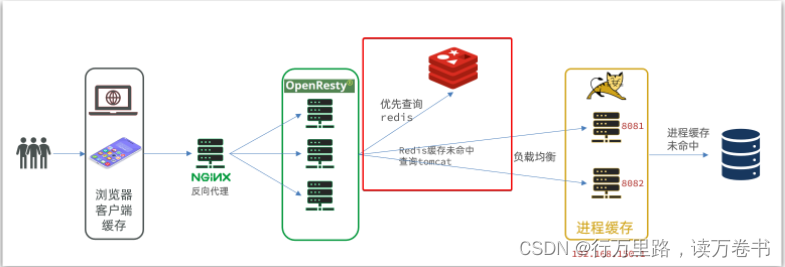
当请求进入OpenResty之后:- 优先查询Redis缓存
- 如果Redis缓存未命中,再查询Tomcat
4.6.1.封装Redis工具
OpenResty提供了操作Redis的模块,我们只要引入该模块就能直接使用。但是为了方便,我们将Redis操作封装到之前的common.lua工具库中。
修改/usr/local/openresty/lualib/common.lua文件:
1)引入Redis模块,并初始化Redis对象-- 导入redis local redis = require('resty.redis') -- 初始化redis local red = redis:new() red:set_timeouts(1000, 1000, 1000)- 1
- 2
- 3
- 4
- 5
2)封装函数,用来释放Redis连接,其实是放入连接池
-- 关闭redis连接的工具方法,其实是放入连接池 local function close_redis(red) local pool_max_idle_time = 10000 -- 连接的空闲时间,单位是毫秒 local pool_size = 100 --连接池大小 local ok, err = red:set_keepalive(pool_max_idle_time, pool_size) if not ok then ngx.log(ngx.ERR, "放入redis连接池失败: ", err) end end- 1
- 2
- 3
- 4
- 5
- 6
- 7
- 8
- 9
3)封装函数,根据key查询Redis数据
-- 查询redis的方法 ip和port是redis地址,key是查询的key local function read_redis(ip, port, key) -- 获取一个连接 local ok, err = red:connect(ip, port) if not ok then ngx.log(ngx.ERR, "连接redis失败 : ", err) return nil end -- 查询redis local resp, err = red:get(key) -- 查询失败处理 if not resp then ngx.log(ngx.ERR, "查询Redis失败: ", err, ", key = " , key) end --得到的数据为空处理 if resp == ngx.null then resp = nil ngx.log(ngx.ERR, "查询Redis数据为空, key = ", key) end close_redis(red) return resp end- 1
- 2
- 3
- 4
- 5
- 6
- 7
- 8
- 9
- 10
- 11
- 12
- 13
- 14
- 15
- 16
- 17
- 18
- 19
- 20
- 21
- 22
4)导出
-- 将方法导出 local _M = { read_http = read_http, read_redis = read_redis } return _M- 1
- 2
- 3
- 4
- 5
- 6
完整的common.lua:
-- 导入redis local redis = require('resty.redis') -- 初始化redis local red = redis:new() red:set_timeouts(1000, 1000, 1000) -- 关闭redis连接的工具方法,其实是放入连接池 local function close_redis(red) local pool_max_idle_time = 10000 -- 连接的空闲时间,单位是毫秒 local pool_size = 100 --连接池大小 local ok, err = red:set_keepalive(pool_max_idle_time, pool_size) if not ok then ngx.log(ngx.ERR, "放入redis连接池失败: ", err) end end -- 查询redis的方法 ip和port是redis地址,key是查询的key local function read_redis(ip, port, key) -- 获取一个连接 local ok, err = red:connect(ip, port) if not ok then ngx.log(ngx.ERR, "连接redis失败 : ", err) return nil end -- 查询redis local resp, err = red:get(key) -- 查询失败处理 if not resp then ngx.log(ngx.ERR, "查询Redis失败: ", err, ", key = " , key) end --得到的数据为空处理 if resp == ngx.null then resp = nil ngx.log(ngx.ERR, "查询Redis数据为空, key = ", key) end close_redis(red) return resp end -- 封装函数,发送http请求,并解析响应 local function read_http(path, params) local resp = ngx.location.capture(path,{ method = ngx.HTTP_GET, args = params, }) if not resp then -- 记录错误信息,返回404 ngx.log(ngx.ERR, "http查询失败, path: ", path , ", args: ", args) ngx.exit(404) end return resp.body end -- 将方法导出 local _M = { read_http = read_http, read_redis = read_redis } return _M- 1
- 2
- 3
- 4
- 5
- 6
- 7
- 8
- 9
- 10
- 11
- 12
- 13
- 14
- 15
- 16
- 17
- 18
- 19
- 20
- 21
- 22
- 23
- 24
- 25
- 26
- 27
- 28
- 29
- 30
- 31
- 32
- 33
- 34
- 35
- 36
- 37
- 38
- 39
- 40
- 41
- 42
- 43
- 44
- 45
- 46
- 47
- 48
- 49
- 50
- 51
- 52
- 53
- 54
- 55
- 56
- 57
- 58
4.6.2.实现Redis查询
接下来,我们就可以去修改item.lua文件,实现对Redis的查询了。
查询逻辑是:- 根据id查询Redis
- 如果查询失败则继续查询Tomcat
- 将查询结果返回
1)修改/usr/local/openresty/lua/item.lua文件,添加一个查询函数:
-- 导入common函数库 local common = require('common') local read_http = common.read_http local read_redis = common.read_redis -- 封装查询函数 function read_data(key, path, params) -- 查询本地缓存 local val = read_redis("127.0.0.1", 6379, key) -- 判断查询结果 if not val then ngx.log(ngx.ERR, "redis查询失败,尝试查询http, key: ", key) -- redis查询失败,去查询http val = read_http(path, params) end -- 返回数据 return val end- 1
- 2
- 3
- 4
- 5
- 6
- 7
- 8
- 9
- 10
- 11
- 12
- 13
- 14
- 15
- 16
- 17
2)而后修改商品查询、库存查询的业务:

3)完整的item.lua代码:-- 导入common函数库 local common = require('common') local read_http = common.read_http local read_redis = common.read_redis -- 导入cjson库 local cjson = require('cjson') -- 封装查询函数 function read_data(key, path, params) -- 查询本地缓存 local val = read_redis("127.0.0.1", 6379, key) -- 判断查询结果 if not val then ngx.log(ngx.ERR, "redis查询失败,尝试查询http, key: ", key) -- redis查询失败,去查询http val = read_http(path, params) end -- 返回数据 return val end -- 获取路径参数 local id = ngx.var[1] -- 查询商品信息 local itemJSON = read_data("item:id:" .. id, "/item/" .. id, nil) -- 查询库存信息 local stockJSON = read_data("item:stock:id:" .. id, "/item/stock/" .. id, nil) -- JSON转化为lua的table local item = cjson.decode(itemJSON) local stock = cjson.decode(stockJSON) -- 组合数据 item.stock = stock.stock item.sold = stock.sold -- 把item序列化为json 返回结果 ngx.say(cjson.encode(item))- 1
- 2
- 3
- 4
- 5
- 6
- 7
- 8
- 9
- 10
- 11
- 12
- 13
- 14
- 15
- 16
- 17
- 18
- 19
- 20
- 21
- 22
- 23
- 24
- 25
- 26
- 27
- 28
- 29
- 30
- 31
- 32
- 33
- 34
- 35
- 36
- 37
- 38
4.7.Nginx本地缓存
现在,整个多级缓存中只差最后一环,也就是nginx的本地缓存了。如图:

4.7.1.本地缓存API
OpenResty为Nginx提供了shard dict的功能,可以在nginx的多个worker之间共享数据,实现缓存功能。
1)开启共享字典,在nginx.conf的http下添加配置:# 共享字典,也就是本地缓存,名称叫做:item_cache,大小150m lua_shared_dict item_cache 150m;- 1
- 2
2)操作共享字典:
-- 获取本地缓存对象 local item_cache = ngx.shared.item_cache -- 存储, 指定key、value、过期时间,单位s,默认为0代表永不过期 item_cache:set('key', 'value', 1000) -- 读取 local val = item_cache:get('key')- 1
- 2
- 3
- 4
- 5
- 6
4.7.2.实现本地缓存查询
1)修改/usr/local/openresty/lua/item.lua文件,修改read_data查询函数,添加本地缓存逻辑:
-- 导入共享词典,本地缓存 local item_cache = ngx.shared.item_cache -- 封装查询函数 function read_data(key, expire, path, params) -- 查询本地缓存 local val = item_cache:get(key) if not val then ngx.log(ngx.ERR, "本地缓存查询失败,尝试查询Redis, key: ", key) -- 查询redis val = read_redis("127.0.0.1", 6379, key) -- 判断查询结果 if not val then ngx.log(ngx.ERR, "redis查询失败,尝试查询http, key: ", key) -- redis查询失败,去查询http val = read_http(path, params) end end -- 查询成功,把数据写入本地缓存 item_cache:set(key, val, expire) -- 返回数据 return val end- 1
- 2
- 3
- 4
- 5
- 6
- 7
- 8
- 9
- 10
- 11
- 12
- 13
- 14
- 15
- 16
- 17
- 18
- 19
- 20
- 21
- 22
- 23
2)修改item.lua中查询商品和库存的业务,实现最新的read_data函数:

其实就是多了缓存时间参数,过期后nginx缓存会自动删除,下次访问即可更新缓存。
这里给商品基本信息设置超时时间为30分钟,库存为1分钟。
因为库存更新频率较高,如果缓存时间过长,可能与数据库差异较大。
3)完整的item.lua文件:-- 导入common函数库 local common = require('common') local read_http = common.read_http local read_redis = common.read_redis -- 导入cjson库 local cjson = require('cjson') -- 导入共享词典,本地缓存 local item_cache = ngx.shared.item_cache -- 封装查询函数 function read_data(key, expire, path, params) -- 查询本地缓存 local val = item_cache:get(key) if not val then ngx.log(ngx.ERR, "本地缓存查询失败,尝试查询Redis, key: ", key) -- 查询redis val = read_redis("127.0.0.1", 6379, key) -- 判断查询结果 if not val then ngx.log(ngx.ERR, "redis查询失败,尝试查询http, key: ", key) -- redis查询失败,去查询http val = read_http(path, params) end end -- 查询成功,把数据写入本地缓存 item_cache:set(key, val, expire) -- 返回数据 return val end -- 获取路径参数 local id = ngx.var[1] -- 查询商品信息 local itemJSON = read_data("item:id:" .. id, 1800, "/item/" .. id, nil) -- 查询库存信息 local stockJSON = read_data("item:stock:id:" .. id, 60, "/item/stock/" .. id, nil) -- JSON转化为lua的table local item = cjson.decode(itemJSON) local stock = cjson.decode(stockJSON) -- 组合数据 item.stock = stock.stock item.sold = stock.sold -- 把item序列化为json 返回结果 ngx.say(cjson.encode(item))- 1
- 2
- 3
- 4
- 5
- 6
- 7
- 8
- 9
- 10
- 11
- 12
- 13
- 14
- 15
- 16
- 17
- 18
- 19
- 20
- 21
- 22
- 23
- 24
- 25
- 26
- 27
- 28
- 29
- 30
- 31
- 32
- 33
- 34
- 35
- 36
- 37
- 38
- 39
- 40
- 41
- 42
- 43
- 44
- 45
- 46
- 47
-
相关阅读:
Kubernetes初始化失败dial tcp 127.0.0.1:10248: connect: connection refused.
JMeter添加插件
剑指offer经典题目整理(二)
OpenAI开发者大会:定义未来AI的新功能、愿景和商业版图
【机器学习】准确率、精确率、召回率、误报率、漏报率概念及公式
保卫城市消费券安全,从这些做起
Frp实现内网穿透
Springboot构建多模块项目
【算法入门&搜索法】走迷宫|单源最短路径1
读《大话数据结构》溢彩加强版
- 原文地址:https://blog.csdn.net/qq_40742428/article/details/127681636
